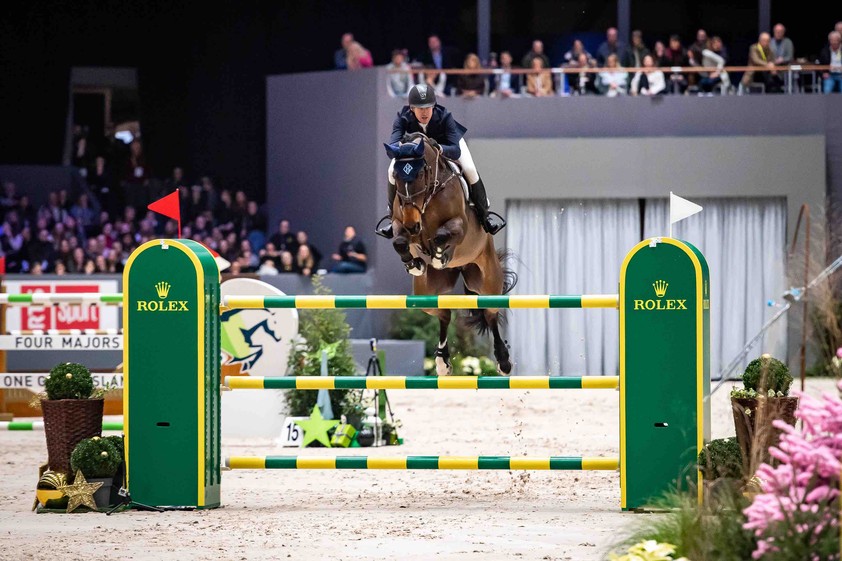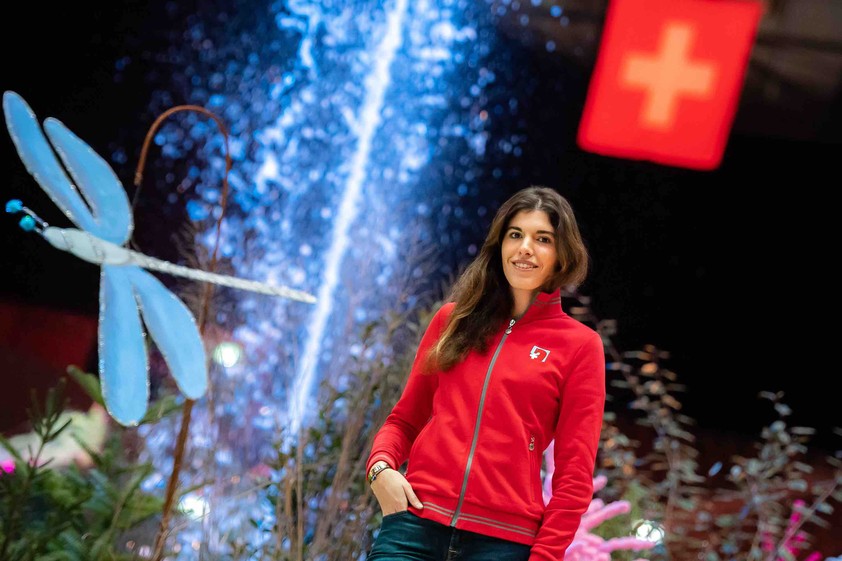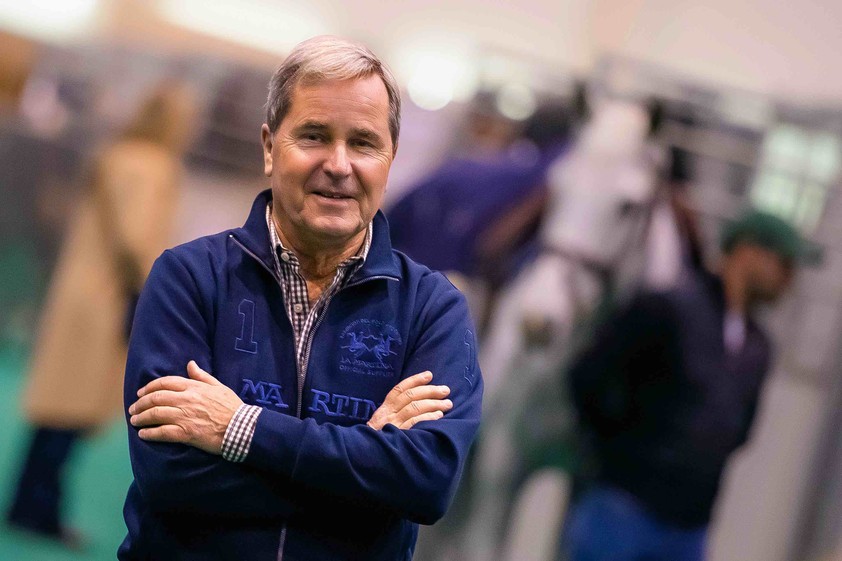McLain Ward wins the Rolex Grand Prix at CHI Geneva and becomes the Rolex Grand Slam Live Contender
Before the Rolex Grand Prix – the highlight class of the 61st edition of CHI Geneva – got underway, 8,000 adoring fans said farewell to an all-time great horse, Martin Fuchs’ legendary gelding, Clooney 51, who was retired in August 2021. After winning this Rolex Grand Slam Major in 2019 with the now 16-year-old grey, a visibly emotional Fuchs paraded Clooney to each corner of the Geneva Arena, to rapturous applause and cheering from all who watched on, before closing with a short speech honouring his loyal companion.
The scene was then set for this year’s Rolex Grand Prix, in which 40 horse and rider combinations representing 14 nations – including 16 out of the current top 20-ranked riders – lined-up, each staking a claim for one of the sport’s most sought-after prizes, as part of their Rolex Grand Slam quests. Course designers Gérard Lachat and Louis Konickx set a technical, 14-obstacle first round test, which would be followed by a nine-effort jump-off, should two or more partnerships navigate the opening round without a fault.
Great Britain’s Ben Maher (Dallas Vegas Batilly) recorded the 1.60m class’s first clear, emulated soon after by Daniel Deusser of Germany with Scuderia 1918 Tobago Z. At the halfway stage, a further seven riders had gone clear, including Gilles Thomas (Calleryama), French duo Kevin Staut (Scuderia 1918 Viking d'la Rousserie) and Simon Delestre (Cayman Jolly Jumper), Andre Thieme (DSP Chakaria) and Christian Ahlmann (Dominator 2000 Z) of Germany, Dane Andreas Schou (Darc de Lux), and Irishman Shane Sweetnam (James Kann Cruz). The second half of the round witnessed just four additional riders progressing to the jump-off, with the Oxer-Liverpool (6a) proving to be the trickiest and most knocked down. These riders included crowd favourites, Martin Fuchs (Leone Jei) and Elian Baumann (Little Lumpi E), American McLain Ward (HH Azur), and a delighted Daniel Bluman of Israel (Ladriano Z), making a final shoot-out of 13 pairings.
Rolex Grand Slam Live Contender, Daniel Deusser set the early jump-off pace and put the pressure on after becoming the first to go double clear in a time of 42.58 seconds. However, it wasn’t to be a second consecutive Major victory for Deusser after Simon Delestre went 0.12 seconds faster, with the Frenchman’s time soon being eclipsed by next gen Belgian talent Gilles Thomas, who went 1.58 seconds quicker still (40.88 seconds). After both Christian Ahlmann and Rolex Testimonee, Kevin Staut were unable to go clear, Saturday’s winner of the Credit Suisse Challenge, Shane Sweetnam, looked like a man possessed, going clear and knocking Thomas off top spot in 40.48 seconds, a time that looked unbeatable. However, next into the arena, Martin Fuchs proved Thomas’ time in fact was beatable, going sub-40 seconds (39.77 seconds), and in turn sending the crowd wild. With penultimate rider Daniel Bluman putting one down, Fuchs’ destiny lay in the hands of American McLain Ward and his 16-year-old bay mare HH Azur. Renowned for their speed and accuracy, the pair glided around the course, going faster than Fuchs at the first two sectors, eventually clearing the final fence over a second quicker than the Swiss, etching their names into Rolex Grand Slam history, with Ward ultimately becoming the Live Contender.
On his first Rolex Grand Slam of Show Jumping Major victory and where it ranks among his career wins, McLain Ward, said: “To win the Rolex Grand Prix of Geneva ranks right up amongst the very greatest moments. Olympic gold medals, the Grand Prix in Calgary – this is a very special moment.”
And on what makes CHI Geneva such a special place to compete at, McLain Ward, commented: “Its people! I mean, it’s spectacular, the atmosphere, the environment, the organisers and sponsors make it so special that the competitors rise to the day.”
Meet the Next Gen:
Alexandra Amar
Why is CHI Geneva such a special show?
It’s a home show so it’s already something special, as you’re competing in front of your home crowd, which is really lovely. For my part, I’ve been selected to compete at CHI Geneva three times, which means a lot to me. Michel Sorg, who is responsible for the [Swiss Team] selection is always believing in me and always giving me my chance. And of course, CHI Geneva is the most beautiful indoor show in the world, so it’s always a very special feeling to be competing here.
How much inspiration do you take from fellow Swiss riders, such as Martin Fuchs and Steve Guerdat?
When I was a little kid I was always lining-up to get a signature from Martin and Steve, so to be competing with them is something that means a lot to me. I’ve been dreaming of it and working hard, and now being there with them, my dreams are kind of coming true. This year, we can also speak about Edouard [Schmitz], who is competing at 5* level; he has had a wonderful year, and I think he is now an idol, who we can all take inspiration from.
Which horses are you competing with this week?
I’ve had a bit of disappointment jumping here this week, as I brought a very green horse with me to jump at this level, to give him his chance, but maybe it was a little bit early. The horse is Lyon Van De Plataan, he’s 10-years-old and a super-quick horse and very competitive, especially at this level. But this arena is very spooky, with a lot of things to look at, so for a horse who is a little bit green, it was maybe a little bit too early, but he’s definitely a horse for the future and one we will keep an eye on.
Which of your young horses are you most excited about?
That’s an easy question! I currently have a seven-year-old, who my trainer Constant Van Paesschen is riding. She’s a wonderful horse and I think next year we will definitely see her competing in the ranking classes. I’m taking her back this winter so I’m very excited. It’s a horse who I love, it’s a horse we have bred, so I’ve literally been growing with her. In two years’ time I believe we’ll see her jumping some of the biggest competitions in the world – she is fantastic.
What are you dreams and ambitions for 2023?
I’ve been selected again for the Swiss team, so I would like to confirm my place and take part in a few Nations Cup competitions, and eventually I would really enjoy stepping up a little bit, which I will really work for. Maybe I can jump my first 5* show in St. Gallen, or get my first selection in a really big event, which would absolutely be a dream for me next year.
What’s the proudest moment of your career so far?
There have been a lot of really happy moments. I would have to say last year when I became Swiss champion with Vinci [Du Gue] – that was something very special, which I was working towards a lot, and with no faults, it meant a little bit extra. I’ve been really proud of how I’ve managed my championships and the way my horse has been with me and fighting for me, so this has probably been the best moment in my career so far.
Who has inspired you the most throughout your career?
Definitely my dad. My trainer, Constant Van Paesschen, has been super with me, carrying me through the sport and helping me through the ups and downs. But my dad has really taught me a lot of important things, not just in sport, but also life lessons that you can apply to sport. He’s taught me to be a fighter and to never let myself down, to take my own path and to just go for it, and I think that’s the most precious lesson that someone could give me.
What advice would you give to someone considering a career in show jumping?
Just believe in your dreams. I used to be a little kid, who was lining up for riders’ signatures, watching those riders with stars in my eyes. But don’t ever think it’s easy, as it’s a hard path, but don’t give up and just go for it.
In your opinion, how positive an impact has the Rolex Grand Slam of Show Jumping had on the sport?
Rolex has always been a wonderful sponsor and a wonderful support for the sport – they’ve made this Rolex Grand Slam circuit legendary. Scott Brash contributed to it by winning the Rolex Grand Slam, which I thought would be impossible, but he made the impossible possible. For me, it’s a just a timeless concept. It’s made up of four of the biggest competitions in the world, the four competitions, which every single rider dreams of competing at and winning. The Grand Slam of Show Jumping will always be a very special circuit and in the hearts of every single rider in the world.
What are your passions away from show jumping?
I study law, so I would say that I am also 100% in my studies. It’s something that has become a passion, which I guess is mandatory to be able to study law, as if you don’t love it you just won’t make it. I play tennis, which helps me to take a break from show jumping – I think we all need something in order to escape and to breathe different air when show jumping becomes a bit too heavy. All of my hobbies are more of less associated with sport and studies.
The Vet Check:
Dr. Marco Hermann
What is your role at CHI Geneva?
I am the veterinary delegate for the FEI at CHI Geneva. I am in charge of looking at the veterinary rules set by the FEI and making sure that they are implemented correctly. This starts with the organisation of the veterinary team and examination of the horses on arrival, making sure that they are sound, that they do not have any signs of the EHV virus or any other contagious disease and ensuring that the horses are fit to compete. Another important job that we have is conducting doping tests and treating any horses onsite who have become unwell or lame.
Have you worked on any other international equestrian events?
I have been fortunate to be able to work on a variety of different international events with the FEI. I was the veterinary delegate for CSI Zürich for 30 years, as well as for CSIO St. Gallen for almost 40 years. I am also in charge of the veterinary service at CHI Basel and was a member of the vet commission at the FEI World Championships in Herning last August.
This is the second year that I will be the veterinary delegate at CHI Geneva. Before, you could work at an event with no break, but nowadays the veterinary delegate (VD) has to change every three years, so next year will be my last year working as VD at CHI Geneva.
How important is nutrition for a horse’s wellbeing?
A horse’s wellbeing is very important – in my opinion it is as important as it is for athletes, although, it is not as well researched as it is in high level human athletes. The horse’s digestive tract needs a lot of fibre, but nowadays people tend to treat a horse’s nutrition as they would a human athlete’s. People now give their horses food with a lot of ingredients that are highly concentrated – horses cannot process this type of food because their digestive tracts are still the same as they were many years ago. In my opinion, the old way of feeding horses is the best way and the supplements that are sold now are not so suitable for a horse’s natural system.
Why did you decide to become an equine vet? Did anyone inspire you?
It was easy for me – even when I was at school, I always wanted to be an equine vet. I do not think anyone inspired me, but for some reason it was always clear to me that this was what I wanted to do. I didn’t even grow up in a horse family – my family was more into cars.
What career achievement(s) are you most proud of?
When you get older you realise that you have done a lot of things. I think the thing that I most proud of is that I built a good reputation in Switzerland and that I am a well-respected member of the veterinary community who is known to have good professional knowledge. I did a lot of colic surgery when I was still fully practicing, and I was able to build up a private clinic which I sold five years ago. It still has a very good reputation and that is the thing that I am most proud of.
What do you enjoy most about being an equine vet?
The thing that I enjoy most about being an equine vet is being able to work with horses – they are the love of my life. Being able to spend so much time with them is a privilege – although sometimes I wish I didn’t have to deal with their owners, but that is not possible! I love being able to treat horses and find out how to help them so that they are no longer lame or ill.
What advice would you give to someone wanting to become an equine vet?
I think that nowadays the younger generation shows more interest in the ‘life’ aspect of the ‘work-life balance’, but to be an equine vet requires a full engagement. You have to be completely devoted to this career, and it will be more ‘work’ than ‘life’. Another key quality that I think people have to have is patience – it is one of the most important things that you need in order to work with horses.
What is a typical day for you like?
It is difficult to say now because I am partially retired, so I can enjoy my life a bit more. I no longer have to drive all day to clients like I did for many years – it could sometimes be from 6am in the morning to 10pm at night. In the past I also used to help students in the clinic. Veterinary practices are open seven days a week, 24 hours a day, which meant sometimes I would be operating all night.
I still have some clients, such as Steve Guerdat and the Fuchs family , who are some of the best show jumpers in the world. I work from my car privately, so I do not need to have a clinic or employees anymore.
Tell us a little bit about your team at CHI Geneva…
At CHI Geneva there will be four vets at all times, two official FEI vets and two t treating vets. It depends on which event you are working at but generally the more horses there are, the more vets need to be on-site. For example, at CSIO St. Gallen, we have five or six vets on-site at all times.
Now you have retired, what legacy do you think you have left in equestrianism?
Now I have partially retired, I spend a lot of time giving speeches and seminars, especially to people who are amateurs and do not compete at a high level. Often, they have a full-time job alongside having a horse, and so I think that sometimes they do not understand the complexity of horses because they do not spend all their time looking after them. I try to educate them on what horses need in order to perform best, how to feed them correctly and how to be a better horseman.
The welfare of the horse underpins what the Rolex Grand Slam of Show Jumping stands for; how do you ensure this is upheld and veterinary standards are constantly improving?
To me, communication is the key, and we need to include all stakeholders in the industry, including riders, grooms, owners and officials, in the conversations. We need to consider all aspects of the sport, but the key thing that we need to remember is that the horse should always be at the centre of these conversations.
Sometimes it can be difficult because there is a lot of money involved and people also have their own personal goals and ambitions within the sport. However, it is so important to recognise that horses are living animals and they are not machines – you cannot just turn them on and off like you would with a car.
In your opinion, what more can be, and should be, done to improve the welfare of the horse?
I think that maybe we should limit the amount of high level competitions and large classes that horses compete in over the course of the year. In our sport we have so many great and well organised events – such as the Rolex Grand Slam of Show Jumping Majors – that there are so many opportunities to compete at the very highest level and often the prize money is so good that riders are tempted to jump in more classes. Therefore, often the horses do not have enough time to fully rest and recover between classes. I think that most top riders understand this, but I think that we should help them to make an informed decision about which tour they follow and what their annual plan is for each of their individual horses – in the end this will stop people over jumping their horses and will thus improve the welfare of the horse.



